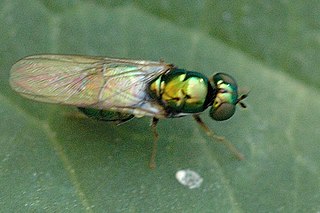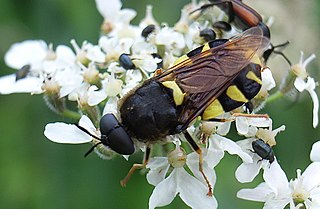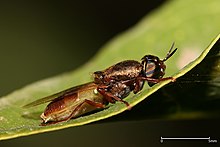
Microchrysa is a genus of soldierfly belonging to the family Stratiomyidae. There has been some confusion with the synonym Chrysomyia of Macquart, 1834, causing some members of the genus Chrysomya of Robineau-Desvoidy, 1830 to be placed erroneously in this genus.
Odontomyia microleon is a European species of soldier fly.

Stratiomys is a genus of flies in the family Stratiomyidae.

Stratiomyini is a tribe of flies in the family Stratiomyidae.

Stratiomyinae is a subfamily of flies in the family Stratiomyidae.

Clitellariinae is a subfamily of flies in the family Stratiomyidae.

Pachygastrinae is a subfamily of flies in the family Stratiomyidae.

Ptecticus is a genus of flies in the family Stratiomyidae. The ground colour of the body may be yellow, brown or black, and the abdomen often shows a degree of transverse stripes. They may mimic parasitic wasps in appearance and habits. The wings are often dusky and the second abdominal segment may be translucent. A well-developed inner projection of the second antennal segment is characteristic for the majority of Ptecticus species. Their larvae are broad, flat and segmented maggots, which may be found in fermenting fruit. As of 2000, 40 species were known from the Old World alone. There are at least 150 described species in Ptecticus worldwide.

Pantophthalmus is a genus of large, robust flies whose larvae feed on living and dead trees, and contains all but one of the species in the family Pantophthalmidae.

Solva is a fly genus in the family Xylomyidae, the "wood soldier flies".

Cyphomyia is a genus of flies in the subfamily Clitellariinae.

Xylomya is a fly genus in the family Xylomyidae, the "wood soldier flies".

Psellidotus is a genus of flies in the family Stratiomyidae.

Hedriodiscus is a genus of flies in the family Stratiomyidae.
Cephalochrysa is a genus of flies in the family Stratiomyidae.
Nigritomyia is a genus of flies in the family Stratiomyidae.
Lasiopa is a genus of flies in the family Stratiomyidae.
Rosapha is a genus of flies in the family Stratiomyidae.
Salduba is a genus of flies in the family Stratiomyidae.












